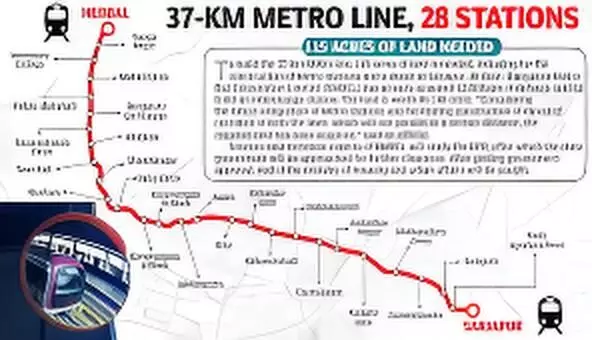Work Begins on Bengaluru’s Namma Metro Red Line Corridor Under Phase 3 Project
Bengaluru’s Namma Metro Phase 3 Red Line project kicks off with a ₹6.86 crore geotechnical survey tender. The corridor will connect Hebbal to Sarjapur, easing traffic and boosting citywide connectivity.
Bengaluru’s Namma Metro Red Line under Phase 3 will connect Hebbal to Sarjapur, enhancing city connectivity and reducing traffic congestion.

The Namma Metro Phase 3 project, which was eagerly awaited, has now started with the Red Line corridor, the most important part to north connect Hebbal and south Sarjapur. The new line is intended to be a solution to the traffic problem and to give better access to the city through the rapidly developing easterly and southerly regions.
🚇 Red Line Corridor: A Key Urban Link
The Bangalore Metro Rail Corporation Limited (BMRCL) has invited tenders amounting to ₹6.86 crores for the geotechnical investigation of the planned Red Line route. The cut-off date for tender proposals is November 3, and the chosen contractor will be given 150 days to finish the survey.
This corridor is a segment of the first phase of the Namma Metro expansion, which is part of the 3A metro connectivity with the underserved areas. At the moment, the Green, Purple, and Yellow Lines are in use, and the Pink Line (Kalena Agrahara to Nagawara) is scheduled to be operational by 2026, followed by the Blue Line (Silk Board to Kempegowda International Airport) in 2027.
🧱 Purpose of the Geotechnical Study
Geotechnical work is an essential preliminary stage for the BMRCL, as it will analyze the survey of the drilling and soil test for the project after its completion. Additionally, it will help determine the adequacy of foundation depth for the aerial structures and the sub-surface tunnels on the route.
Moreover, it will point to the right TBMs (Tunnel Boring Machines) to be used on the project and will also make the contractors to have the right cost estimations.
🏙️ Impact on Bengaluru’s Urban Mobility
The Red Line will have a combination of underground and overhead sections, with the route going through the city's central areas. When the project is finished, the time taken for moving from one end of Bengaluru to the other will be cut down considerably, leading to less traffic on the main streets and improved last-mile service.
With the advancement of the Red Line, Bengaluru's metro system is constantly expanding and its vision of an effortless urban transport network that decreases reliance on private cars is getting closer to realization.

